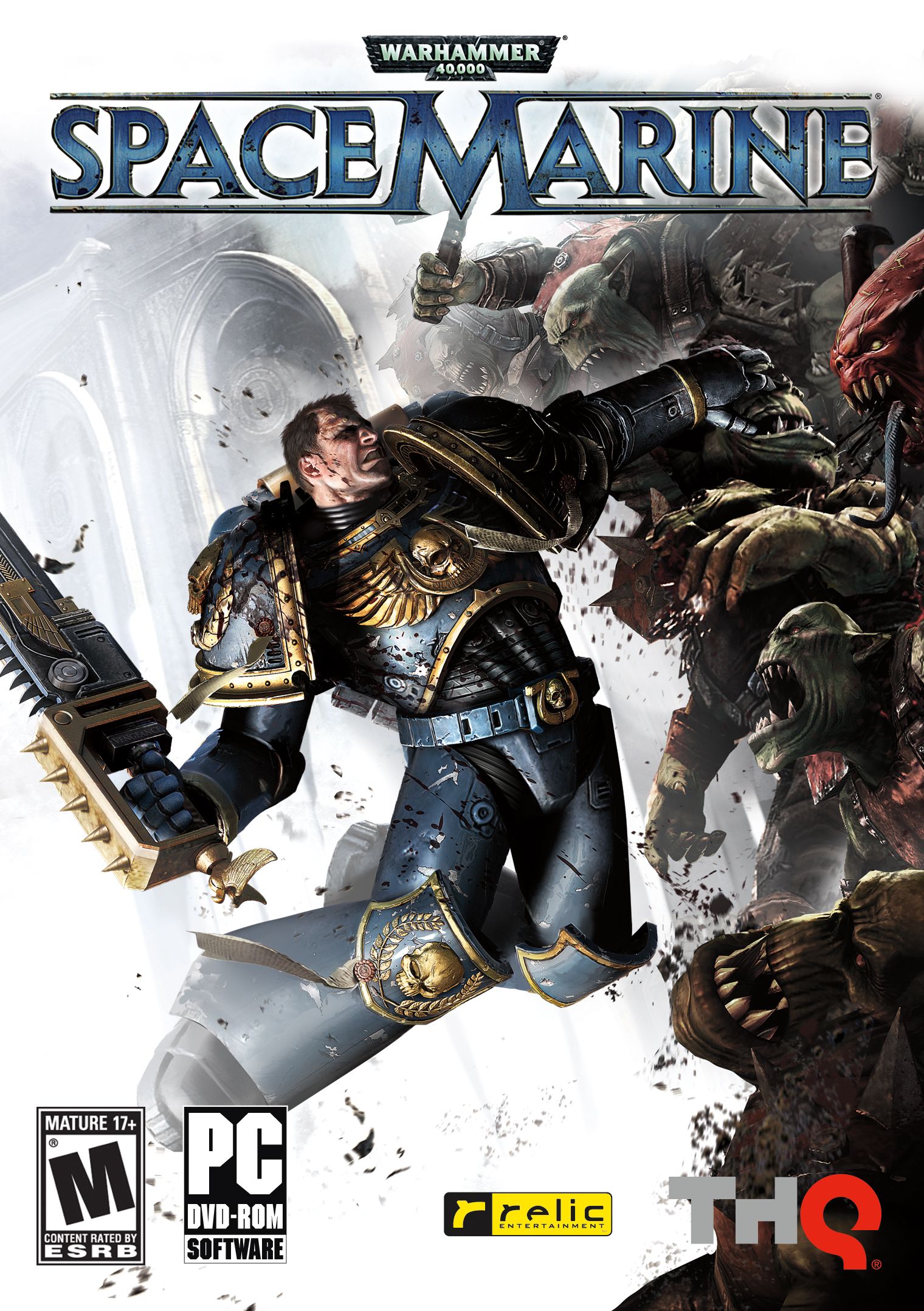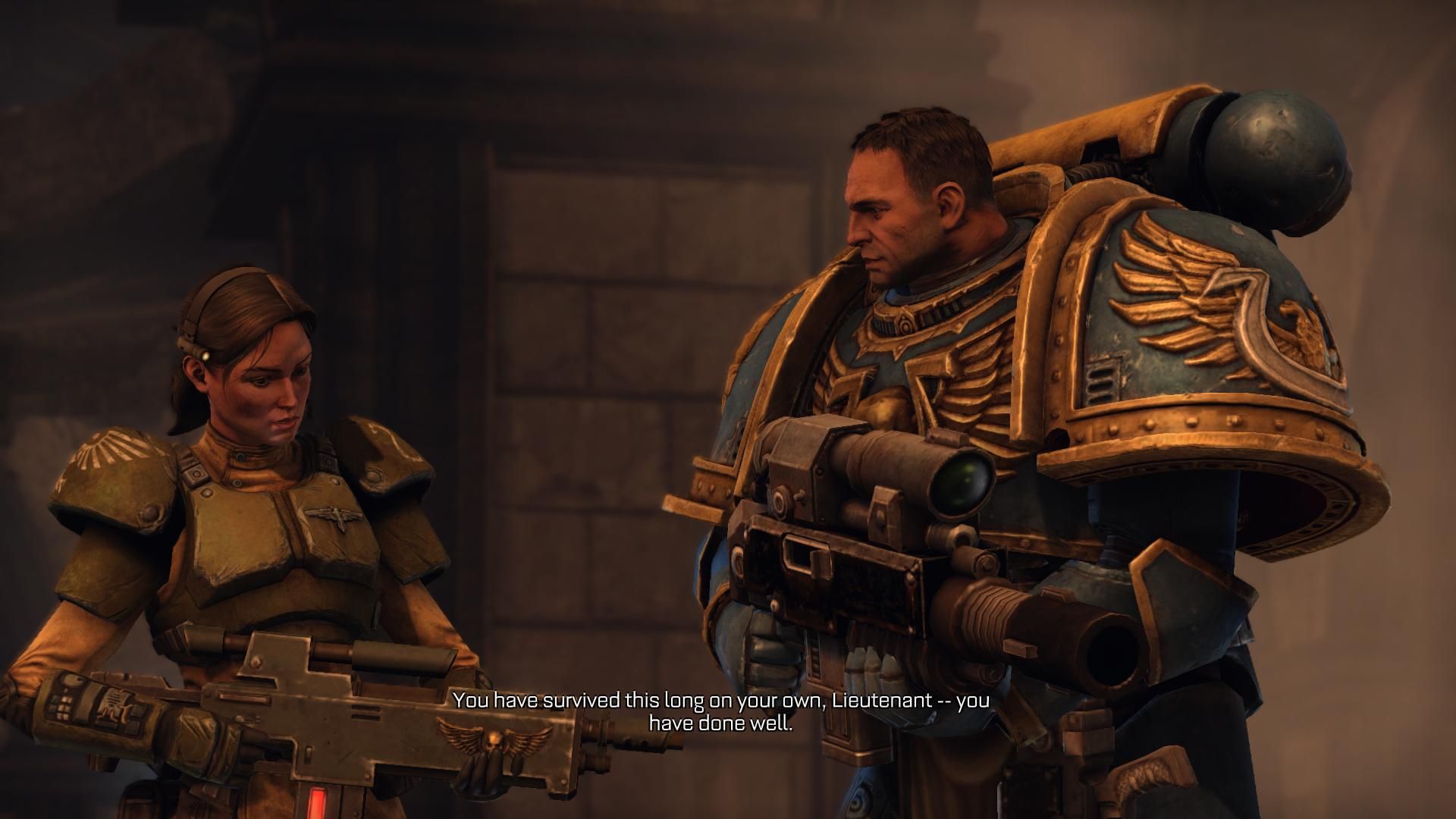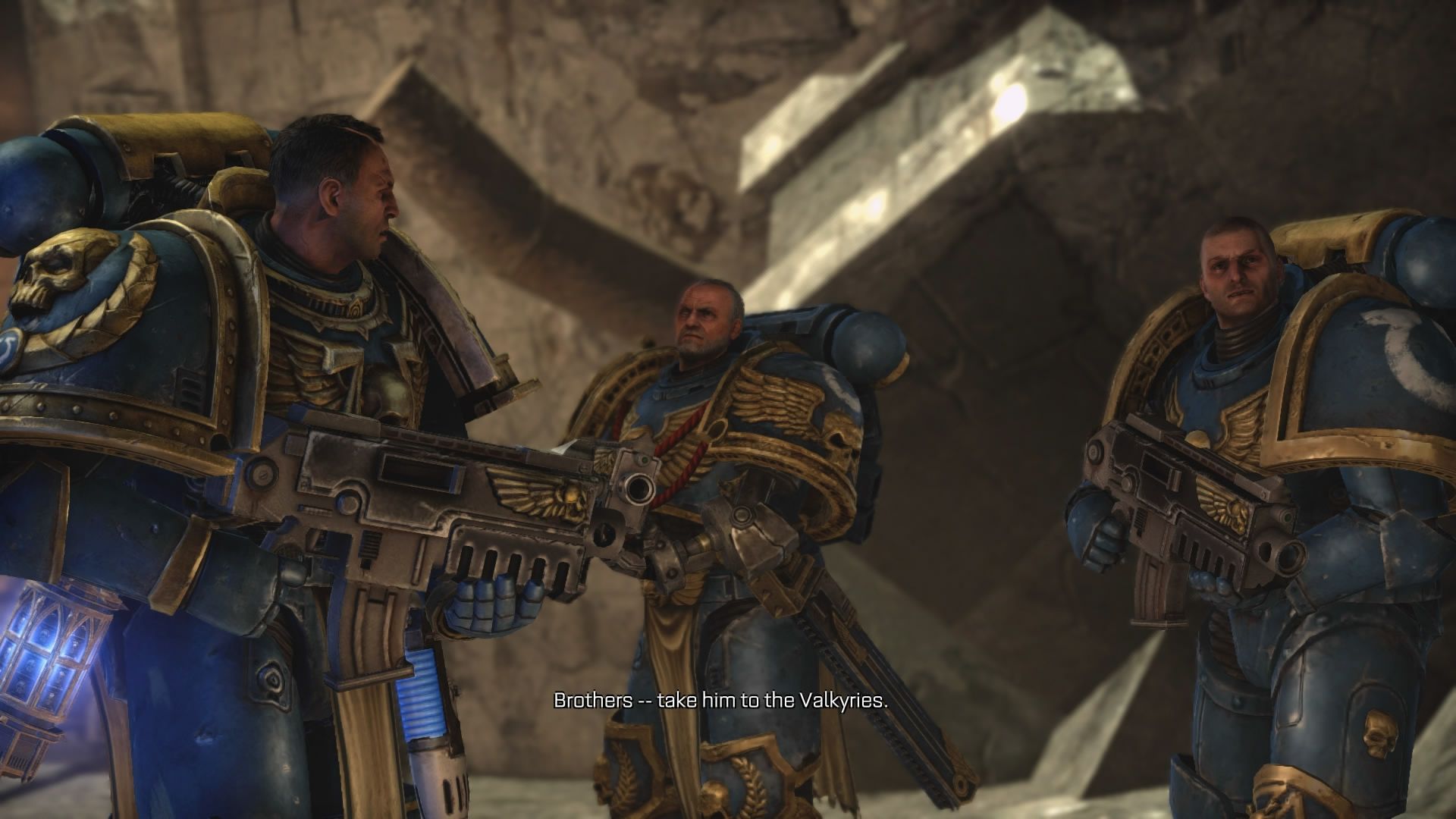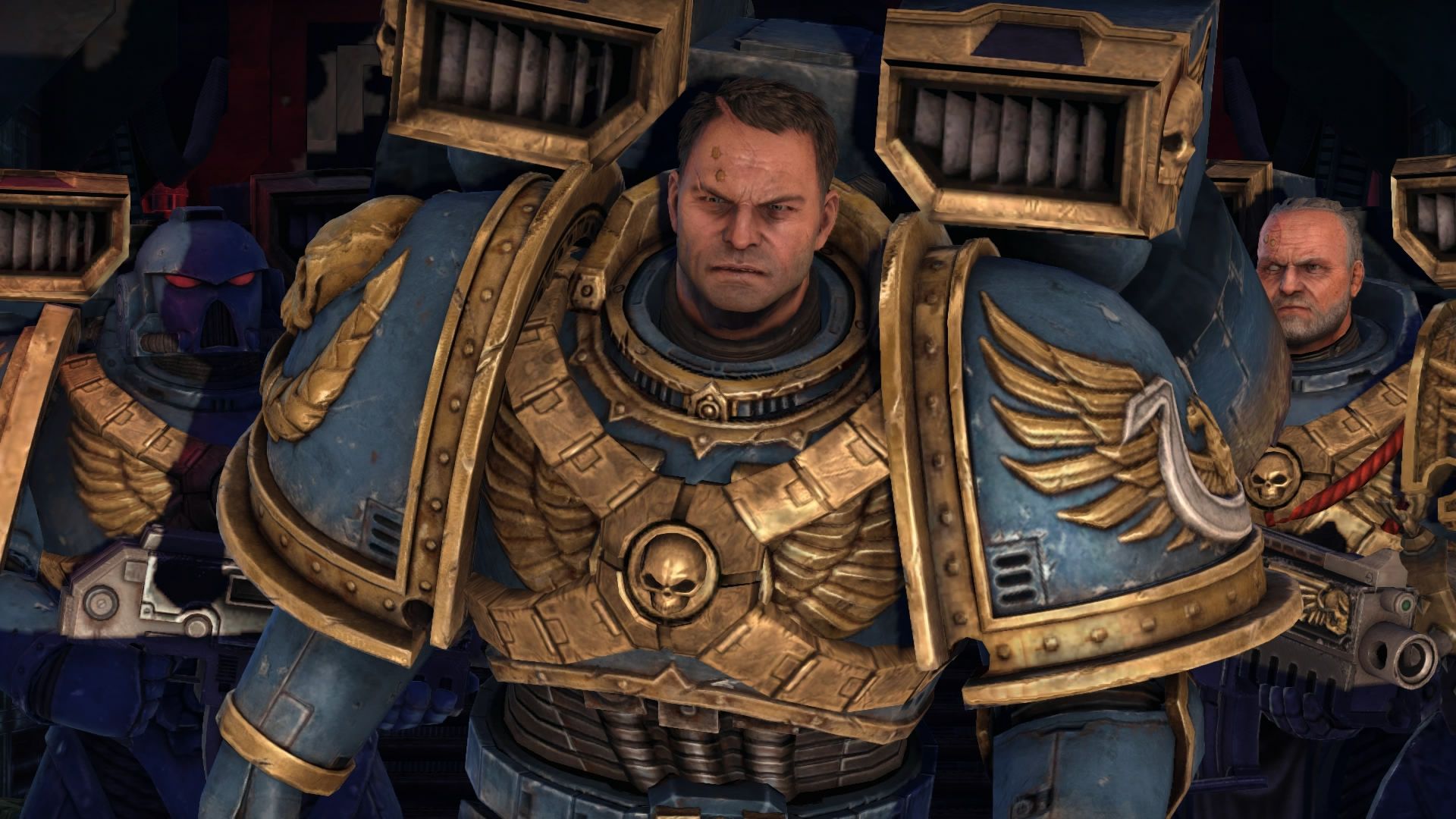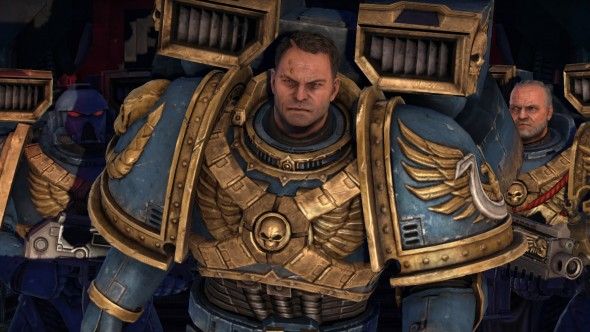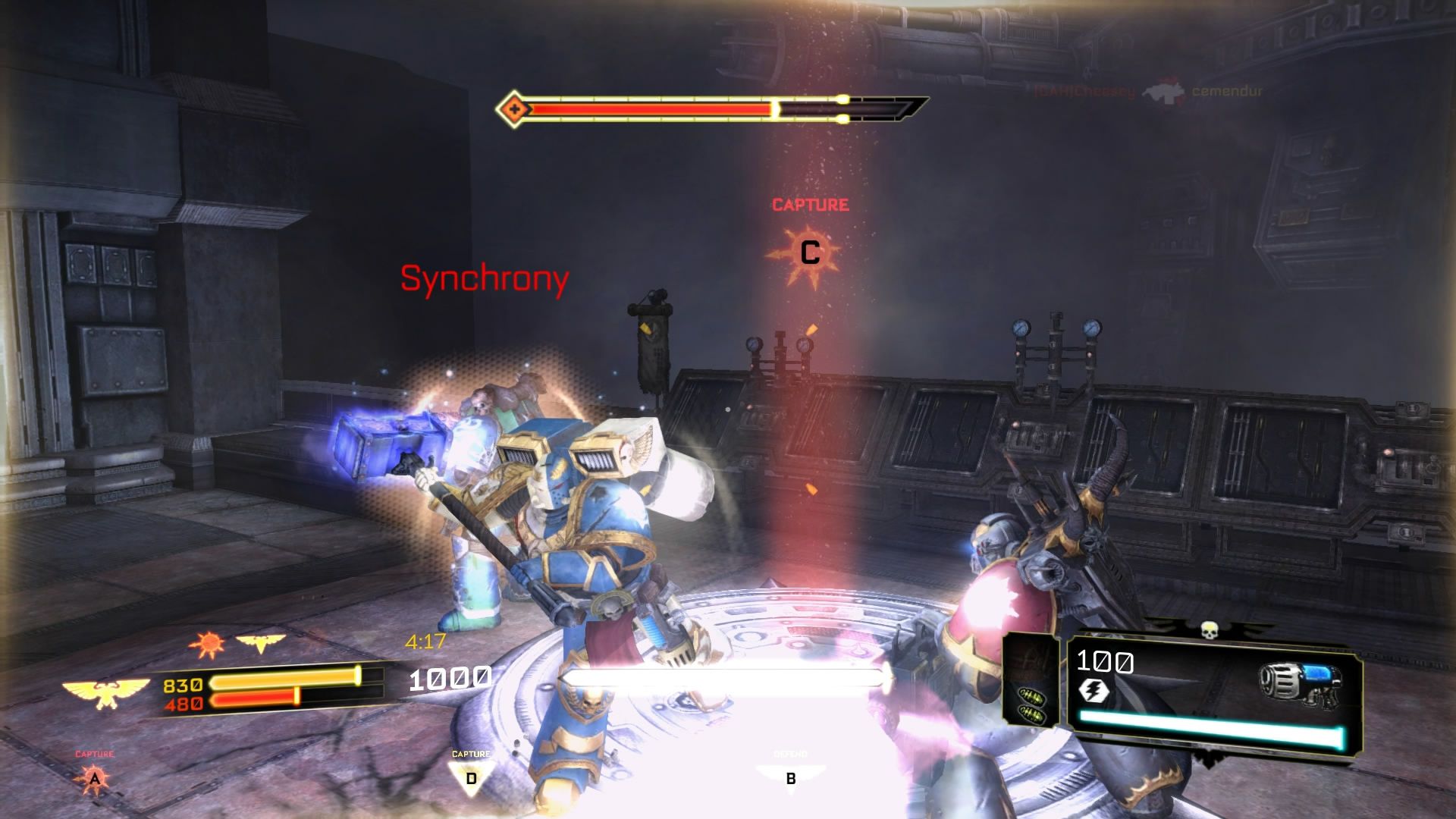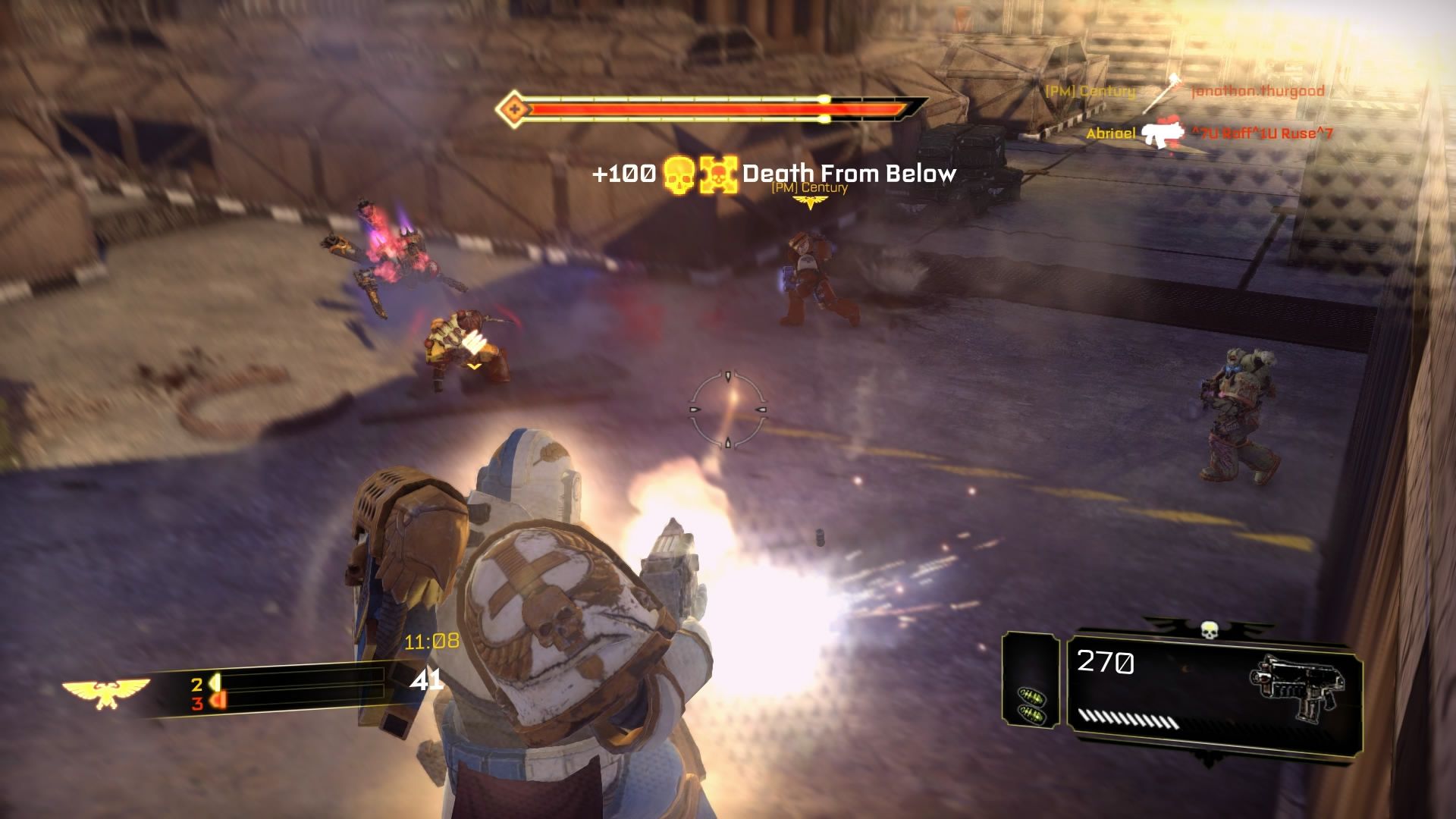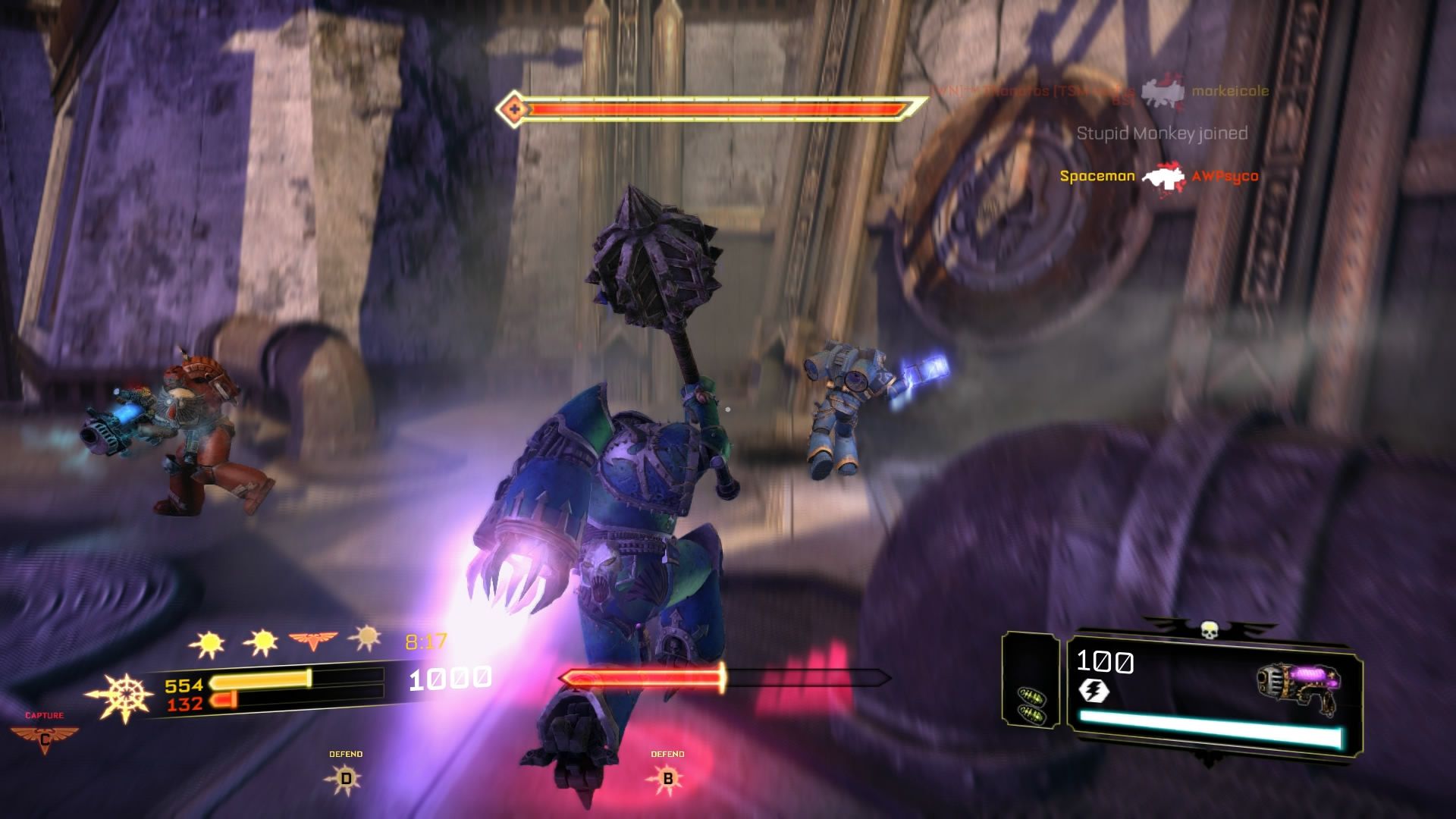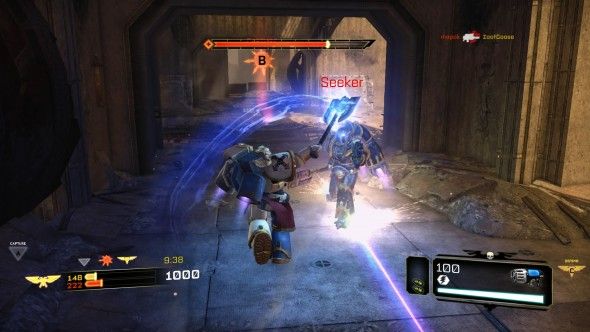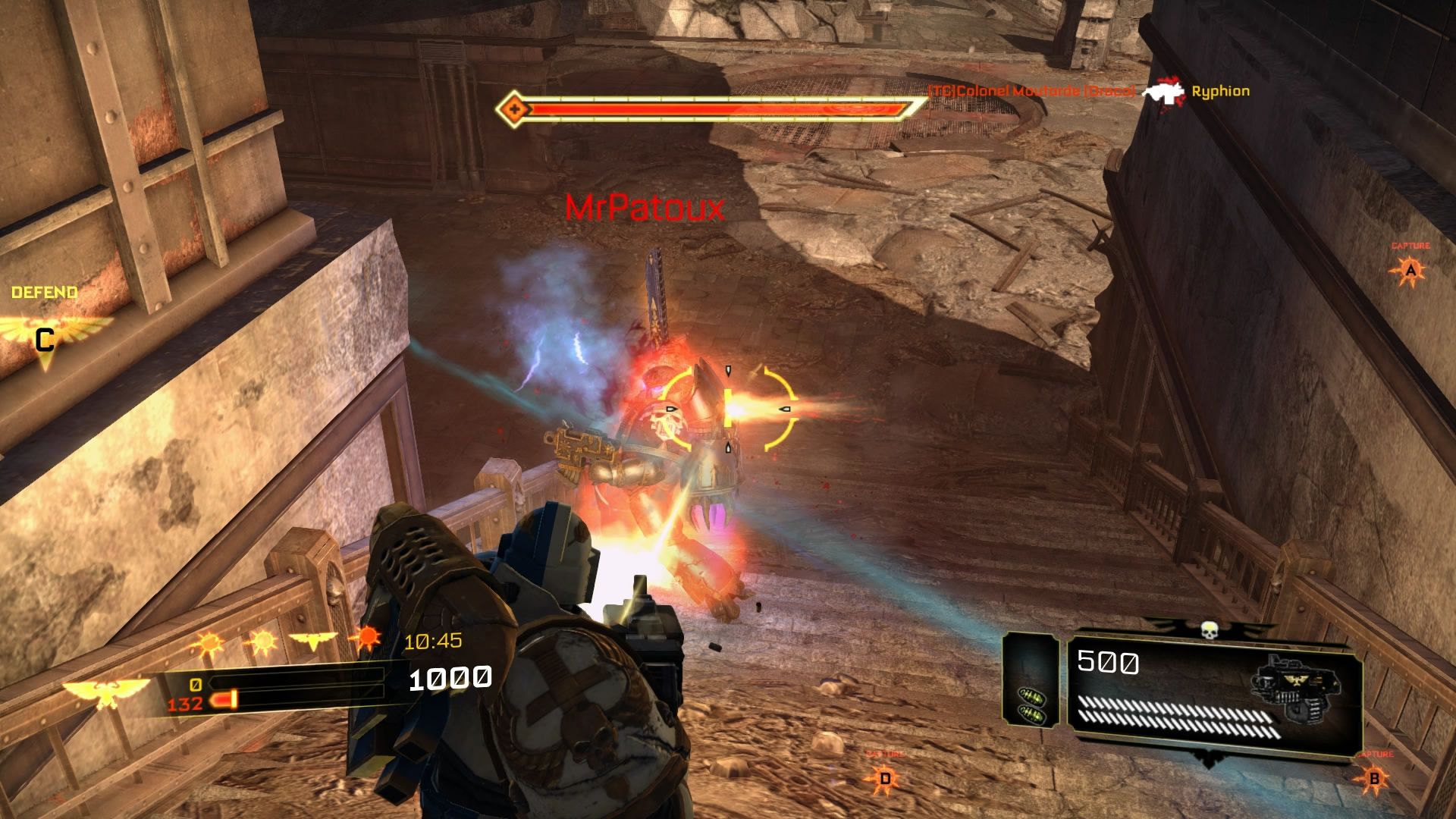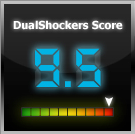In the grim darkness of the far future mankind wavers on the brink of extinction. The Imperium of Man is under attack from all sides by ruthless aliens and threatened from within by heretics and rebels. Only the will of the immortal Emperor protects the human race from annihilation. Countless warriors are under his command, and between them the strongest are the Space Marines, mentally and physically engineered to be the most lethal fighting force in the galaxy.
Titus is the captain of the Second Company of the Ultramarines, one of the most respected chapters of Space Marines. He and his men have been dispatched to the forge world of Graia to counter an invasion by the savage Orks. The planet is defended by the glorious Cadian Imperial Guards, but the guardsmen are no Space Marines and they are quickly getting overrun as the enemy forces include millions of brutal aliens.
As he lands on Graia Titus knows that the situation is desperate, but no battle is too hopeless for a Space Marine, even if something far more sinister may be hiding behind the scenes.
Warhammer 40,000 is probably one of the best Sci-fi settings ever written, and with a history made of twenty-three years of rulebooks, sourcebooks, novels, games and even a CG movie, it's definitely one of the deepest and most complex. This complexity is normally both a blessing and a curse for game developers, as while it provides an extremely detailed background to write a good story, it's also very difficult to create one that will fit seamlessly into a very established canon.
Relic promised a much more cinematic and story-driven approach with Space Marine than the one we saw on the Dawn of War series, and in this they have definitely succeeded. The story is one of the strong points of the game, showing an interesting contrast between epic undertones and a feeling of uncomfortable oppression due to the ruthless methods of the Imperial Inquisition, that often feel delightfully alien themselves.
http://www.youtube.com/embed/y-QSvJ3K--Q
One of the most solid elements of the story are it's characters. The Space Marines are so strongly conditioned to be the perfect warriors that it's extremely difficult to turn them into likeable characters. Luckily the writers of Space Marine didn't seem to suffer from this problem, as all three of the Ultramarines that form Titus' squad are interesting and absolutely far from the rather boring idea that many have of the finest soldiers of the 41st millennium.
Titus is extremely determined and strong on the surface, but he's definitely not immune from doubt and feelings, creating a relentless but somewhat troubled hero that it's hard not to like. He contrasts starkly with Leandros that is apparently much more inflexible in his faith into the Codex Astartes (a set of rules that lays at the foundation of most Space Marine chapters), but hides even bigger weaknesses. And how not to like Sidonus? The gruff but somewhat fatherly sergeant is simply perfect for the role of the group's veteran.
There isn't much space under the spotlight for women in the Warhammer 40,000 universe (and they cannot be Space Marines), but Relic always managed to put some interesting female characters in their previous takes on the IP. Macha, Taldeer and Governor Elena Derosa are all rather memorable characters in the Dawn of War series, but they pale in comparison with their female colleague in Space Marine: Lieutenant Mira is brave, though as nails, and definitely the perfect example of the fact that in the far future the "weaker" sex is not one bit weak. She also shows a softer side, definitely attracted by Titus' courage and selfless heroism. I wouldn't go as far as defining their relationship romantic, but it's pretty obvious that there's a deeper understanding between them.
Warboss Grimskull does what the Orks do best. He's the perfect stubborn villain that also provides us with a smile because of the somewhat naive and primal nature of the Orks. The only weaker link is, unfortunately, the main villain, Nemeroth. He's far from being a poor character, but he fails to shine as much as the rest of the cast, even if his insinuating and manipulative nature makes him irritating enough.
There are even some winks to the Dawn of War series. I won't spoil anything about the story, but when the situation will grow dire, the Blood Ravens will come to the rescue, fighting alongside Titus in an epic firefight across a bridge, creating one of the most climatic moments of the campaign for those that played end enjoyed Relic's RTS games. Personally I had rather hostile feelings towards the Blood Ravens at the beginning, as I resented Relic's decision to create their own chapter instead of using the ones already established in the Warhammer 40,000 universe. Despite that, their deep lore and complex history grew on me with time and now that the more iconic Ultramarines take the stage, I can say that it was almost emotional to meet the Blood Ravens as companions on the field of battle. I would not be one bit surprised to see them involvement grow with a very possible sequel. If you play the campaign you'll probably understand why.
Don't get me wrong, the plot is definitely self-contained, but it's impossible not to see that it leaves a lot of room for expansion towards a full fledged saga. I would be very surprised not to see THQ announce a Space Marine 2 sometimes soon.
The visuals of Space Marine are nothing short of a feast for the eyes. The Warhammer 40,000 license comes bundled with a very peculiar and delightfully elaborate classical-gothic art style that Relic contributed to evolve even more with the Dawn of War series.
Space Marine is the game that truly shows the result of the joint work of the artists from Games Workshop and Relic, displaying a level of art direction that has very few rivals in the gaming market quality-wise.
While the characters look great, what really shines are the environments, even thanks to the lighting and particle engines that create a really incredible atmosphere. The areas themselves are beautifully designed and memorable, exploiting the peculiar art style and architecture of the Warhammer 40,000 universe perfectly to create a look that is both unique and pleasing to the eye. The visual impact is made even stronger and more epic by how dynamic the environments are. Space Marine saves no effort in reminding us that we are in a war zone: cannons fire in the background, explosions happen basically everywhere, raising dust and smoke, ships fall from the sky and firefights happen often even when the player isn't involved. Sometimes things get even more spectacular, as Titus finds himself fighting on a speeding train or on top of the armored carapace of a walking Warlord Titan.
Size is another dominating theme of Space Marine's visuals. Everything in the game is immense. Just to bring an example, near the beginning of the game Titus and his squad will have to silence a cannon of titanic proportions that's shooting down the vessels coming to reinforce the positions of the Imperial Guard. The cannon dominates the whole battlefield, and every time it fires it completely shakes the whole environment, raising wind and smoke so realistic that you can almost feel the impact in your stomach.
When you manage to get inside the cannon itself, the exposed loading mechanism, carrying truck-sized and beautifully decorated bolts into the barrel, isn't only a great gameplay expedient, but also a work of art of captivating beauty and detail.
Effects are also top-notch, and perfectly integrated with the lighting engine. Explosions, gunfire, psychic lightning and similar lethal emissions create an intricate web of light and smoke across the screen, shedding colorful but realistic light over the environment and the characters, improving the dynamic effect I mentioned above and giving to Space Marine's battles a look that sometimes can even be distracting. All those pretty lights might make you neglect that enemy sneaking behind your back.
Animations complete the game's visuals very nicely. Combat looks dynamic and ruthless, with some of the most brutal finisher moves I ever seen in a game, accompanied by a slow motion effect that underlines them perfectly. Even out of combat the level of animation is always high, especially for our marines, that give the perfect feeling of moving with a heavy Power Armor.
Cutscenes are definitely cinematic, giving a distinctive Hollywood feeling that was missing from the previous Warhammer 40,000 games and further enhancing the atmosphere of the game and of the story. Characters are expressive and "act" their part definitely well. I can't remember a single moment in which I got the robotic feeling I get in many other games when watching the less action-oriented non-interactive sequences.
If you want to see more about the Space Marine's visuals, you can watch the video review embedded above or enjoy my two flickr galleries, that feature both single player and multiplayer.
Audio is another of the strong aspects of the game. I already mentioned the dynamic environments, and the sound effects that come with them are a perfect complement to create a war-torn atmosphere. The sound of the guns are equally well done, and especially the ones for the Bolter (that we hear a whole lot during the game) are extremely satisfying. An iconic rifle that shoots 19 mm self-propelled mini-rockets really needs an appropriate sound effect, and Space Marine doesn't disappoint.
The musical score is also definitely great and delightfully epic. The tracks are varied, but they keep an overall recognizable style that won't prove alien to those that are familiar with the Dawn of War series. The difference made by the fact that this time the score has been recorded by a live orchestra is audible and makes the whole soundtrack more enjoyable and dynamic.
A cinematic story wouldn't be complete without a great voice-over work and Space Marine fully delivers in this aspect as well. The deep, manly voice of Mark Strong is simply perfect on Titus, giving him an extremely determined but also deeply thoughtful feel. All the other voice actors are no less great in their roles, improving the hollywood feeling given by the story-driven parts of the game and providing depth to their characters. As a side note, Mira's british accent is delightful.
Gameplay-wise Space Marine isn't an overly complex game, and does not try to be. It can be considered a third-person shooter only because of the fact that you see your character in third person and that sometimes you shoot, but it's very unique compared to the rest of the genre, as it's more a brawler in many aspects.
First of all, there's no cover. Sure, you can walk behind an obstacle and hope that it will deflect some bullets, but that's only a temporary solution, as most enemies are definitely melee-heavy and will swarm you and chop you down quickly if you don't pull out your hand-to-hand weapon and start to do some slicing and dicing yourself.
Secondly, there's no healthcare in Space Marine. No healthpacks, medipacks or similar healing implements. The primary way to heal yourself is to stun an enemy and perform one of the game's ruthless finishers on him. This will trigger an healing effect that will keep you alive together with your armor, that regenerates over time when you're not being hit.
Put together the lack of solid cover with the need to surgically divide your enemies in multiple parts to heal yourself, and you get a battle system in which the player is strongly encouraged to get toe-to-toe with the opposition instead of sitting back and taking pot shots at them. This is not to say that guns aren't important, as the game lets the player move between ranged and melee attacks in a delightfully seamless way. One moment you'll be smashing your chainsword through the thick skull of an Ork, and a second later you'll whip out your Bolter to shoot his mate in the face.
The result of this mating between shooting and slashing, alongside with the aforementioned brutal finishers, creates one of the fastest, exciting and ruthless battle systems I tried in a game of this genre.
The lack of a cover system may lead some to think that the game isn't tactical. That's quite far from being true. The fatality-to-heal system isn't that easy to execute efficiently. Do it while surrounded by enemies, and they'll continue to hit you while you dismember their unfortunate companion, negating the healing effect. This means that positioning and timing are extremely important, as you'll find yourself maneuvering around the enemy ranks in order to isolate one in order to finish him off before the others get their paws (and axes) on you.
In addition to that, there's a wide variety of enemies in the game, and they all need to be fought in different ways. Quite often, between apparently mindless hordes of foes, there will be some stronger ones (sometimes strong enough to be considered mini-bosses in their own right) that, if not spotted and countered in time and in the right way, will quickly send you to your doom.
Moving further past the second half of the game, the relatively mindless Orks will be replaced by Chaos Space Marines and Demons, providing a great change of pace. Chaos Space Marines are armed and Armored exactly as Titus and his men are and can prove very challenging opponents, especially if supported by renegade psykers that will quickly strip you of your armor with their beams. if you didn't learn to use your abilities and weapons tactically against the Orks, you'll be in a world of pain when the forces of Chaos will make their entrance.
This isn't to say that the Orks are pushovers themselves. They just tend to throw themselves at you with a little less care for their survival. Overall, the AI is impressive, probably due to Relic's experience with RTS games. Enemies will flank you, attack you from varied directions, throw grenades often if they can't hit you with their normal weapons and effectively position themselves to try and cause the most havoc, with ranged troopers in the back and melee-oriented enemies swarming you. This, combined with the wide variety of foes, including some very nasty surprises like the suicide squigs, keeps the level of challenge high, and forces the player to be on his toes and think tactically almost all the time.
The tools of mayhem at your fingertips are just as varied: You go from extremely satisfying melee weapons like the Power Axe and the Thunder Hammer to ranged ones like your standard issue bolter (that despite being standard, is probably one of the most fun weapons to use in the game, even more so when upgraded to the Kraken pattern), the sniper-oriented Stalker bolter, the close-ranged but devastating Melta Gun, and quite a few others, ensuring great variety and tactical options. You can go fully close-combat oriented with the Thunder Hammer, that will have you forgo the use of heavy weapons, retaining only the Bolt Pistol and the Bolter, but is absolutely devastating, or take a more balanced approach with the chainsword or the power axe, that will let you carry a very respectable ranged firepower.
You'll also find some turrets armed with Heavy Bolters and Plasma cannons, and you can tear off the weapons from them for overwhelming firepower (or just man them and let it rip), but those can't be reloaded, so once you finish the magazine they'll have to be abandoned.
My only issue with the choice of weapons is rather personal, and comes from being an avid Warhammer 40,000 player. The lack of extremely cool weapons like the Lightning Claws or the Power Fist is a bit saddening (but hey, there's always space for them in a sequel), but what I can definitely take issue with is limiting something as iconic as the Power Sword to a bonus for completing the first mission in Warhammer 40,000: Kill Team and for preordering the PC version from THQ itself (which means that European gamers are, as usual, cut out). The tie-in with Kill Team would have been much more acceptable if completing the mission would have given a code usable on any platform, but since there's no PC version of the twin-stick shooter, gamers that bought the PC version of Space Marine are out of luck, especially if they live in Europe.
Through the campaign your equipment will also progress, granting much needed additional protection and upgrades to your fury mode, a definitely useful "smart bomb" that charges while you fight and that will make you almost invincible for a few seconds, also doubling up as a secondary healing source if you're hard pressed.
In the end, the level of challenge and the upgrades to your equipment are very well balanced on normal difficulty, ensuring that you'll never find yourself hopelessly outgunned, but the enemies will always offer a solid opposition, unlike many other shooters that turn you into a battlefield god as you start acquiring the most advanced weaponry.
Despite the degree of variation offered by the different weapons, some may find themselves wanting more, and Space Marine delivers further diversity by letting you use a jump pack to take the battle to the sky and and rain destruction on your foes from above. You can access the jump pack only at specific points during the story, but they provide a very well placed change of pace, and leaping around over the gorgeous scenery and then diving on your foes like a bird of prey is extremely fun and satisfying.
The game also includes a collectible feature in the form of servo-skulls that are more or less hidden across the single player levels. The best part isn't the reward that comes with them (a couple of achievements), but the fact that each servo skull will relay an audio message from several secondary and flavor characters, contributing to bring the story and the Warhammer 40,000 world alive.
One of the few gameplay-oriented flaws of the game is, unfortunately, your squad itself. While Sidonus and Leandros prove quite talkative and will often engage in conversation with Titus while walking around the levels (often helping to convey the story without the need of going into a cutscene, thing that will please the cutscene-haters among us), you cannot give orders to them and they will always fight independently. Don't get me wrong, they're quite effective in killing the weaker enemies and taking some pressure off your back, but a simple system to give them orders would have increased the tactical depth of the game further, and I personally believe that the overall gameplay would have benefited from it. Moreover, it doesn't make much sense even story-wise: as the Captain of an Ultramarine company Titus is in command of a hundred of the most powerful warriors of the galaxy, but he's not able to yell orders at his own squad mates.
All in all, though, the single player campaign of Warhammer 40,000: Space Marine proves an extremely satisfying festival of unrestricted mayhem, destruction and carnage, with an absolutely top-notch pacing and a gameplay that shines in it's unique mix between melee and shooting. Add to it the great story and the likable characters, and you get a package that wouldn't even need multiplayer to stand on it's own.
But there's multiplayer in Space Marine, and while it may seem a little under featured compared to other games, it definitely offers a lot to enjoy. It's often better to keep things simple, but effective, than make them overly complex and watering down gameplay in the process. Space Marine's multiplayer puts that philosophy into execution almost perfectly.
There are two multiplayer modes in the game, Annihilation and Seize Ground.
Annihilation is your standard 8 vs. 8 squad-based deathmatch, in which the two teams compete to reach 41 kills (if you don't get the reason for the number 41, let's just say that the game is set in the 41st millenium), while Seize Ground brings objectives into the picture, increasing the tactical depth of the game and forcing players to move around to capture the targets and deny them to the enemy. Personally I definitely prefer Seize Ground, as the gameplay is more varied and squad coordination is more determining, but Annihilation can prove definitely fun for the one that looks for less involved mayhem.
The finisher/heal mechanic is absent in multiplayer, replaced by a simpler timed health regeneration. I personally consider this a wise choice, as it simply wouldn't fit multiplayer gameplay and it would marginalize ranged-oriented gamers.
Space Marines and their Chaos counterparts are basically the perfect choice for competitive multiplayer. While they have very distinctive looks that allow for easy recognition on the field of battle and better eyecandy (loads better than simply giving the two teams different colors, sorry Team Fortress 2), their abilities and equipment are specular, as Chaos Space Marines are simply Space Marines turned traitor. This means that the two teams are always perfectly balanced in their potential.
The player can chose between three classes, the melee-oriented Assault, the jack-of-all-trades Tactical, and the ranged-focused Devastator (and their chaos counterparts Raptor, Tactical and Havoc). Each class has access to a different set of weapons, equipment and abilities, granting a nice level of variation.
The fact that Space Marine isn't your typical third person shooter, but includes a strong melee component is a very real advantage over competing games in multiplayer. You like shooting? You can. You like slicing and dicing stuff? You can. You like both? Your time in the game will be even more fun and varied as you can switch between the two play styles whenever you like.
The classes themselves are very well balanced between each other (another boon coming from the relative simplicity of the multiplayer structure). All have weaknesses and strengths, and while a certain degree of Rock-Paper-Scissors approach is present, such advantages and disadvantages are entirely situational, and no class is helpless against another.
For instance as an Assault marine you have the tools to get close and personal against a Havoc, but the Havoc has a "stomp" move that can briefly stun you if you're not fast and unpredictable enough. Tactical Marines don't excel at ranged or melee combat, but can take a Havoc thanks to their higher mobility, or a Raptor by dodging away from it's melee weapons and shooting a Melta Gun right in his face. This means that there's basically no situation, one against one, in which superior skill doesn't give a good chance to win, regardless of class and equipment.
Assault marines probably offer the most unique gameplay experience thanks to their Jump Packs, allowing players to jump high into the sky and dive on unsuspecting enemies like a human (well, not exactly human, given how far the genetic engineering of the Space Marines goes) bomb. It's fun, satisfying, and provides an excellent competitive tool to those gamers that don't exactly excel at aiming (especially with a controller), and that normally are turned off by shooters, massively increasing the accessibility of the game for those that usually don't do well in the genre.
The maps available are very well designed, especially for the Seize Ground mode. All the objective areas offer several access vectors, and the layout is very conductive to encourage both firefights and furious melee. Having played the multiplayer mode for several hours I can say that I still didn't find a safe camping spot, which is rather rare in this kind of game. That's partly due to simple but effective map design, and partly another advantage of the inclusion of melee and jump packs. Sitting back and taking pot shots is possible and effective, but if you aren't careful and don't move often, you'll soon have a couple Raptors diving on your face and tearing you to pieces.
The game provides a progression system that unlocks new weapons, perks and cosmetic pieces of armor as the player grows in level. This grants veteran players a good initial advantage for the time they put into the game, but it's not an "I win" option in itself. When you get killed by another player you can decide to copy his loadout (both equipment and perks) and use it yourself during your next outing, whether you have unlocked the weapons and perks or not. This works as a "great equalizer", allowing rookies to try the more advanced weaponry before they actually get to earn it, even if it doesn't grant the flexibility and stability the actual unlock would give.
If you think that guy wouldn't have killed you if you had access to the same weapons, you just have to copy his loadout and prove it. Simple but effective.
I mentioned cosmetic pieces of armor, and that introduces us to the customizer, which is one of the best areas of the multiplayer mode. You can chose any combination of colors and many shoulder pad emblems for your Space Marine, but that's only the beginning. As you unlock new pieces of armor you can customize your appearance even more, allowing literally millions of different combinations. Helmet, chest, left and right legs, left and right shoulder pads, left and right arms and backpack can all be selected separately, allowing veterans to display their prowess and honors on a master crafted Power Armor or to go with a simpler approach to try and deceive their opponents.
The only thing that's really missing is a cooperative multiplayer mode, as it would really fit both the game and the setting. THQ promised that such a mode (dubbed "Exterminatus") will be made available for free in about a month, but at the moment we still can't enjoy it. What would have really been priceless is the ability to play the single player campaign with two friends manning Sidonus and Leandros, but unfortunately this doesn't seem to be on the menu.
Despite that, the multiplayer of Warhammer 40,000: Space Marine is deceptively simple, but extremely fun and wildly addictive, even thanks to the many unlockables and to the customizer. I normally don't get the "one more match and then I'll sleep" syndrome with other shooters, but this one gave me the even more dangerous "one more match and then I'll write the review" one, which is why our review editor Chad has been staring coldly at me during the last couple days. If this isn't a testament to the quality of the game I don't know what could be.
Ultimately Space Marine is definitely the game that Warhammer 40,000 fans have been waiting for twenty-three years, allowing us to enjoy the unparalleled flavor of the 40k universe from a character's point of view and in an extremely detailed rendition that can only be defined breath-taking. It's beautiful single player story, the brutal gameplay and the simple but extremely well balanced and addictive multiplayer mode turn the game in a must-have for everyone that has even a slight interest in the setting and a great chance to discover it's charm for those that never experienced it, but love shooters. Finally, the solid inclusion of melee mechanics that don't take a back seat compared to shooting allow even those gamers that aren't much into third person shooters to fully enjoy the title.
To put it down simply, Warhammer 40,000: Space Marine is a great game. It fully does justice to the IP without sacrificing gameplay and it can easily stand on par with the best of the genre, while providing something diverse and unique at the same time. Uniqueness, great stories and complex characters are exactly where the third person shooter genre is most often found wanting, and Space Marine delivers.
-
Title: Warhammer 40,000 Space Marine
- Platform Reviewed: PC
- Developer: Relic Entertainment
- Publisher: THQ
- Release Date: September 5, 2011
- MSRP: $49.99 (PC), $59.99 (PS3 and Xbox 360)
- Review Copy Info: A review copy for this title was provided to DualShockers, Inc. by the publisher for the purpose of this review.

